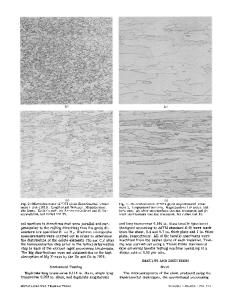The Effect of Methylating Treatments on the Dielectric Reliability of Low-k/Cu Structures
- PDF / 1,529,534 Bytes
- 6 Pages / 612 x 792 pts (letter) Page_size
- 49 Downloads / 279 Views
B8.12.1
The Effect of Methylating Treatments on the Dielectric Reliability of Low-k/Cu Structures Swarnal Borthakur1, 2, Sri Satyanarayana1, Andreas Knorr1, 3, Paul S. Ho2 SEMATECH1, The University of Texas at Austin 2, Infineon Technologies 3 SEMATECH, 2706 Montopolis Drive Austin, TX 78741, USA
ABSTRACT Post ash chemical treatments were evaluated for improving the reliability of Cu/low-k structures. The RC delays, leakage current, ramp-voltage-breakdown and timedependent-dielectric-breakdown lifetimes resulting from different treatments were compared. The pitch dependence of capacitance and breakdown was also evaluated. Post ash chemical treatments were more beneficial for the smaller line spaces. FTIR and TEM/EELS analysis were performed to determine the chemical changes occurring at the sidewall due to the post ash chemical treatments. The analysis showed that the chemical treatments increased the carbon content at the trench sidewalls. The post ash treatments were found to improve the electrical characteristics.
INTRODUCTION As scaling approaches nanometer levels, the RC delay of interconnects has become a dominant factor in determining the total delay. Integration puts severe constraints on the electrical properties of low-k materials. Unoptimized etching, ashing and cleaning processes could potentially damage the dielectric [1]. This damage may be carried forward into subsequent processing steps and ultimately leads to higher effective dielectric constant [2]. The damage also increases the leakage current through the intralevel dielectric (ILD) and compromises the reliability of the interconnect structures. In general, porous low-k materials are more prone to damage compared to dense ILD. Porous materials can easily absorb contaminants from the etchants. The subsequent wet and dry cleaning processes might not completely remove the contaminants and may instead contribute to the deterioration of the dielectric material. In this paper we investigate surface treatments and their effect on dielectric reliability. The treatment chemicals studied were organic compounds with methyl groups [3].
B8.12.2
EXPERIMENTAL DETAILS Single damascene copper/low-k structures were processed. After an etch and ash, a post ash surface treatment was performed. Blanket films were also subjected to similar surface treatments so that an FTIR analysis could be performed. The pitches of the single damascene structures ranged from 0.250µm to 0.525µm. The capacitance was measured on interdigited comb/comb capacitor structures and the resistance was measured on serpentine line resistance structures. The breakdown field is determined from ramp-voltage-breakdown tests performed on the comb/comb test structures. The ramp rate is 3V/sec. The time-dependent-dielectric-breakdown (TDDB) tests were performed on comb/comb structures with 0.125µm line width and 0.175µm line space. All measurements were made at 25oC. RESULTS AND DISCUSSION Five different post-ash treatments were studied. Out of the five treatments (1, 2, 1A, 2A, 3A), 1A, 2A and 3
Data Loading...









